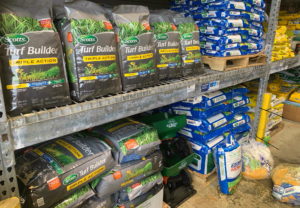How the State’s New Fertilizing Rules Affect Your Lawn Care
November 1st, 2022
Runoff from farms and factories is a key source of water pollution that ends up draining into the Chesapeake Bay, where it’s long harmed the health of aquatic life.

New state rules dictate when and how much fertilizer can be applied to lawns.
But runoff from the fertilizers that go on our ample acreage of home lawns also is a contributor – an estimated 14 percent of the total going into the Bay.
After nearly a dozen years of consideration, Pennsylvania’s state legislature in July passed a set of rules that dictate what kind and how much fertilizer people can apply to their lawn and when they can and can’t apply it.
The rules are similar to ones that several nearby states already have had for years, including Maryland and Virginia.
The rules aren’t so heavy-handed that they’re going to end the days of green-carpet aspirations. They don’t even get into the use of herbicides, insecticides, and fungicides, for example.
Rather, the rules are aimed at curbing the use of fertilizers that aren’t needed. And they apply to homeowners fertilizing their own lawns as well as lawn-care companies and professionals fertilizing park lawns, golf courses, and athletic fields.
For starters, the new rules prohibit the application of any nitrogen- or phosphorus-containing lawn fertilizer between Dec. 15 and March 1… or any other time the ground is frozen to a depth of at least two inches or when snow-covered.
Lawn fertilizer containing phosphorus is prohibited altogether, unless a soil test or other specific documentation shows that the lawn needs it. Most lawn fertilizers already have dropped phosphorus as an ingredient since most soils have enough of this nutrient to adequately grow grass.
Three other exceptions allow phosphorus: 1.) when a new lawn is being established, 2.) when a lawn is being repaired, and 3.) when the phosphorus is in an “enhanced-efficiency” product or in a natural organic or organic-based fertilizer.
Phosphorus rates are capped at a quarter-pound of phosphorus per 1,000 square feet of application with a maximum total annual application of twice that.
The rules also limit amounts of nitrogen that can be applied. Nitrogen is the main nutrient in lawn fertilizers and the one most responsible for dense growth and green color.
Under the rules, nitrogen can’t exceed seven-tenths of a pound of readily available nitrogen per 1,000 square feet (i.e. “fast-release” or water-soluble nitrogen) and can’t exceed nine-tenths of a pound of total nitrogen per 1,000 square feet.
Enhanced-efficiency or “slow-release” nitrogen fertilizers are exempted from the totals so long as the amount of nitrogen released at any given time doesn’t exceed seven-tenths of a pound per 1,000 square feet of application.
As with phosphorus, there’s also an exemption on nitrogen limits when the applicator can show that more is necessary.
Three other rules in the new law:
1.) Non-aquatic fertilizer can’t be applied within 15 feet of the bank of a lake, pond, wetland, stream, creek, or river. Exception: when fertilizer is needed to establish or maintain a stream buffer planting, using a “targeted application technology” such as a drop spreader or directed spray liquid.
2.) Fertilizer can’t be applied over an impervious surface (i.e. a sidewalk, driveway, patio, or street). If any spills there, it must be removed immediately following the application.
3.) Lawn fertilizer can’t be applied with any device that’s not intended for the application of fertilizer or that hasn’t been properly calibrated. Residents also are banned from operating fertilizer application equipment “in a faulty, careless or negligent manner,” and they’re required to dispose of, store, and use fertilizers according to label directions.
The U.S. Environmental Protection Agency has been encouraging states to develop ways to keep nutrient pollution out of waterways, where it leads to excess algae blooms that create “dead zones” in key bodies of water such as the Chesapeake Bay.
Excess or unused nitrogen and phosphorus from lawns can leach or wash by rain into streams, where it starts a journey that ends in the Bay.
The penalty for a first violation of the new lawn-fertilizer rules ranges from $50 to $100.
The first half of November is actually one of the best times of year to fertilize the lawn.
Penn State professor of turfgrass science Dr. Peter Landschoot says that timing provides early grass green-up in spring without the sometimes-excess growth that an early-spring application causes.
He recommends fertilizers that are high in slow-release nitrogen, such as natural organics and products made with IBDU technology. (Fertilizer bags spell out how much of their nitrogen comes from slow-release sources.)
The optimal fertilizer game plan for most Pennsylvania lawns, Landschoot says, includes three applications – once in mid to late spring, once in late summer, and once in early November before the ground freezes.
Check out Penn State’s Turfgrass website for more on fall fertilization of lawns







